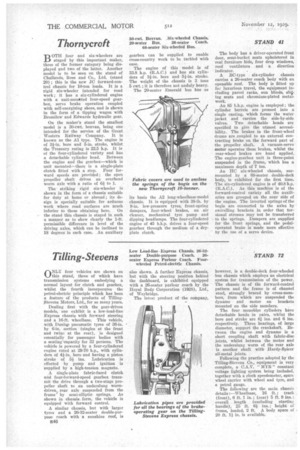Thornycroft
Page 184

If you've noticed an error in this article please click here to report it so we can fix it.
BOTH four and six-wheelers are staged by this important maker, three of the former category being displayed and two of the latter. Another model is to be seen on the stand of Challands, Ross and Co., Ltd. (stand 20) ; this is the new JC forward-control chassis for 10-ton loads. It is a rigid six-wheeler intended for road 'work; it has a six-cylindered engine with a unit-mousted four-speed gearbox, servo brake operation coupled with self-energizing shoes, and is shown in the form of a tipping wagon with Bromilow and Edwards hydraulic gear.
On the maker's stand the smallest model is a 30-cwt. boxvan, being one intended for the service of the Great Western Railway Company. It is known as the Al. type. The engine is of 3i-in, bore and 5-in, stroke, whilst the Treasury rating is 22.5 h.p. It is of the four-cylindered variety and has a detachable cylinder head. Between the engine and the gearbox—which is unit mounted—there is a single-plate clutch fitted with a stop. Four forward speeds are provided ; the open propeller shaft drives an overhead worm axle with a ratio of 6+ to 1.
The striking rigid six-wheeler is shown in the form of a chassis suitable for duty at home or abroad ; its design is specially suitable for arduous work where road surfaces are much inferior to those obtaining here. On the stand this chassis is staged in such a manner as to show clearly the 1-ft. permissible difference in level of the driving axles, which can be inclined to 18 degrees in each case. An auxiliary
gearbox can be supplied to enable cross-country work to be tackled with ease.
The engine of this model is of 33.8 h.p. (R.A.C.) and has six cylinders of 31-in. bore and 51-in. stroke. The weight of the chassis is 3 tons 5 cwt.; it is therefore not unduly heavy.
The 20-seater Emerald bus has as its basis the A2 long-wheelbase-model chassis. It is equipped with by 9-in, low-pressure tyres, front-spring dumpers, four-wheel brakes, an air cleaner, mechanical tyre pump and dipping headlamps. The four-cylindered engine of 45 b.h.p. drive S a four-speed gearbox through the medium of a dryplate clutch. The body has a driver-operated front door, semi-bucket seats upholstered in real furniture hide, four drop windows, roof ventilators and a direction indicator.
A BC-type six-cylinder chassis carries a 26-seater coach body with an openable roof. The body is fitted up fo: luxurious travel, the equipment including parcel racks, sun blinds, sl4lug seats and chromium-plated metalwork.
An 85 b.b.p. engine is employed ; the cylinder barrels are pressed into a. single casting, which forms the water jacket and carries the side-by-side valves. Two detachable heads are specified to give the utmost accessibility. The brakes in the front-wheel drums are ,coupled to an external contracting brake on the forward part of the propeller shaft. A vacuum-servo motor operates these brakes, whilst the rear-wheel brakes are hand applied.. The engine-gearbox unit is three-point suspended in the frame, which has a maximum depth of 7 ins.
An HO six-wheeled chassis, surmounted by a 68-seater double-deck body, is exhibited for the first time. The six-cylindered engine is of 40.8 h.p. (R.A.C.). As this machine is of the forward-control variety all the auxiliaries are grouped on the near side of the engine. The inverted springs of the bogie are connected to the axles by swivelling brackets in order that torsional stresses may not be transferred to the springs. Dampers are supplied for the front springs, and the pedaloperated brake is made more effective by the use of a servo device.








































































































































































































































































































































